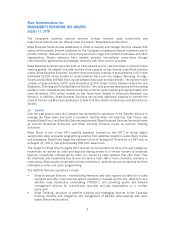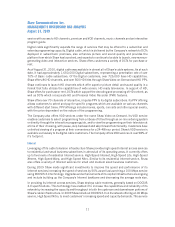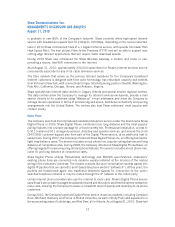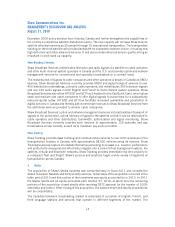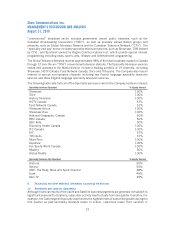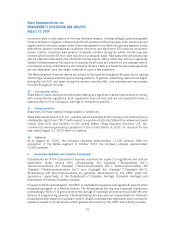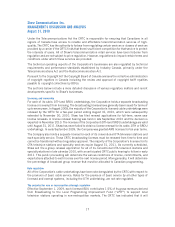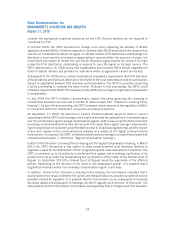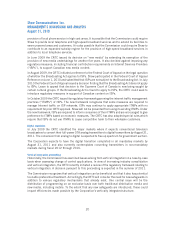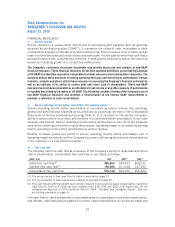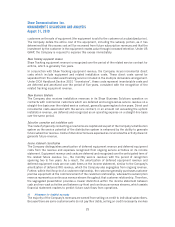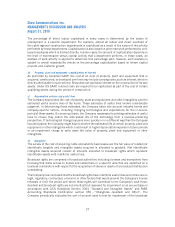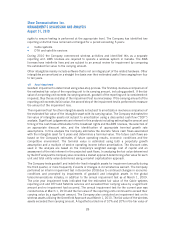Shaw 2010 Annual Report Download - page 23
Download and view the complete annual report
Please find page 23 of the 2010 Shaw annual report below. You can navigate through the pages in the report by either clicking on the pages listed below, or by using the keyword search tool below to find specific information within the annual report.Access rights
Shaw’s cable systems require access to support structures, such as poles, strand and conduits of
telecommunication carriers and electric utilities, in order to deploy cable facilities. Under the
Telecommunications Act the CRTC has jurisdiction over support structures of telecommunication
carriers, including rates for third party use. The CRTC is currently considering the rates for third
party use of telecommunication carrier support structures and could approve an increase in these
rates.
Part II fees
The CRTC collects several different fees from broadcast licensees, including fees collected under
Part II of the Broadcasting License Fee Regulations (the “Part II fees”). In 2003 and 2004, Part II
fees were challenged in the Federal Court on the grounds that the fees are taxes rather than
regulatory charges, and that regulations authorizing them are unlawful. In December 2006, the
Federal Court ruled that the Part II fees were an illegal tax. Both the Crown and the original
applicants to the Federal Court appealed the case to the Federal Court of Appeal, which on April 28,
2008 overturned the Federal Court and ruled that Part II fees are valid regulatory charges. Leave to
appeal the Federal Court of Appeal decision was granted on December 18, 2008 by the Supreme
Court of Canada and a hearing date of October 19, 2009 was set for the appeal.
On October 7, 2009, the Government of Canada and appellants in the Supreme Court of Canada
proceeding announced that they had entered into an agreement whereby parties to whom the Part II
fees applied agreed to discontinue their appeal to the Supreme Court (including the claim for the
recovery of Part II fees paid since 1998). The Government agreed that it would not seek amounts
owing by the industry to the end of the last fiscal year (2007, 2008 and 2009) which had not been
collected while the issue was being appealed in the Courts, and the Government would recommend
that the CRTC develop a new, forward-looking fee regime to replace the Part II fees that would be
capped at $100 million per year, indexed to inflation, for the broadcasting industry. The Notice of
Discontinuance was filed by appellants with the Supreme Court on October 7, 2009.
In December 2009, the CRTC initiated a proceeding calling for comments on proposed
amendments to the Broadcasting License Fee Regulations to reflect the out-of-court settlement
reached between the Government of Canada and members of the Broadcasting industry in October
2009. In July 2010 the proposed amendments were introduced by the Commission.
Digital Phone, New Media and Internet
Regulation of the incumbent local exchange carriers (“ILECs”), competitors of Shaw’s Digital
Phone business, is now largely governed by the current Government’s deregulatory initiatives.
Specifically, in December 2006, the Governor in Council directed the CRTC to “rely on market
forces to the maximum extent feasible as the means of achieving the telecommunications policy
objectives, and when relying on regulation to use measures that are efficient and proportionate to
their purpose and that interfere with the operations of competitive market forces to the minimum
extent necessary to meet the policy objectives”. Over the past several years this has resulted in
numerous forbearance orders being granted to TELUS Corporation (“TELUS”), Manitoba Telecom
Services Inc. (“MTS”), BCE Inc. and/or Bell Canada (collectively “Bell”), and SaskTel that cover the
majority of Shaw’s operating territory.
The CRTC is currently reviewing the obligations of carriers to provide service and to subsidize the
provision of services to customers living in high cost areas. At present, the obligation to serve is
limited to local telephone service and applies only to the incumbent telephone companies. All
telecommunication service providers are also required to contribute to a fund to subsidize the
19
Shaw Communications Inc.
MANAGEMENT’S DISCUSSION AND ANALYSIS
August 31, 2010


